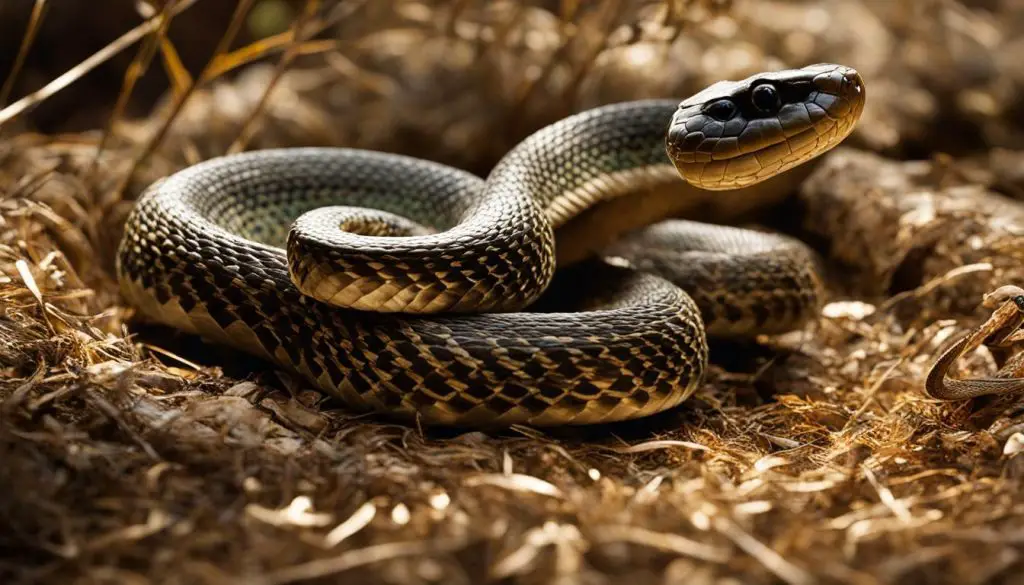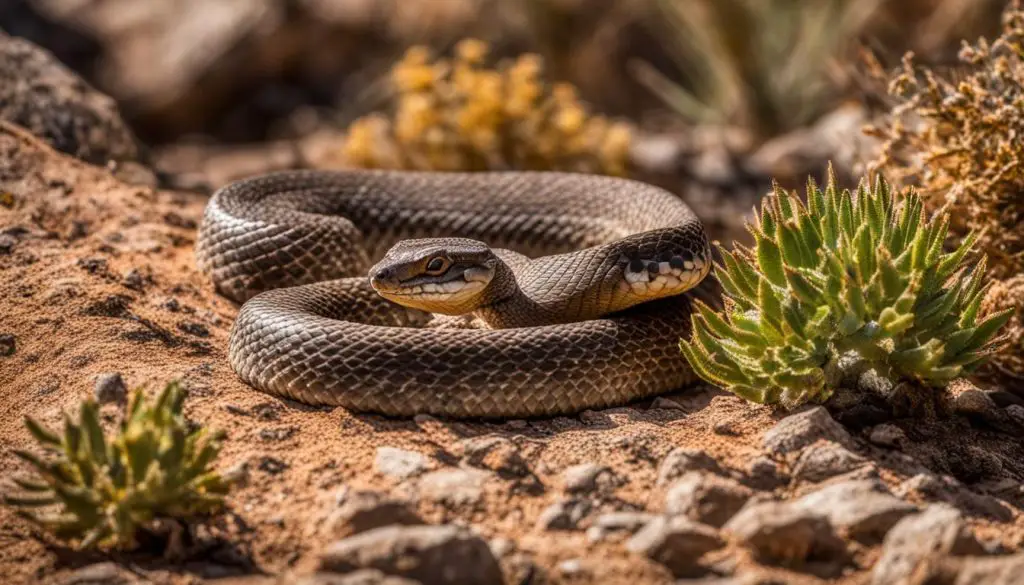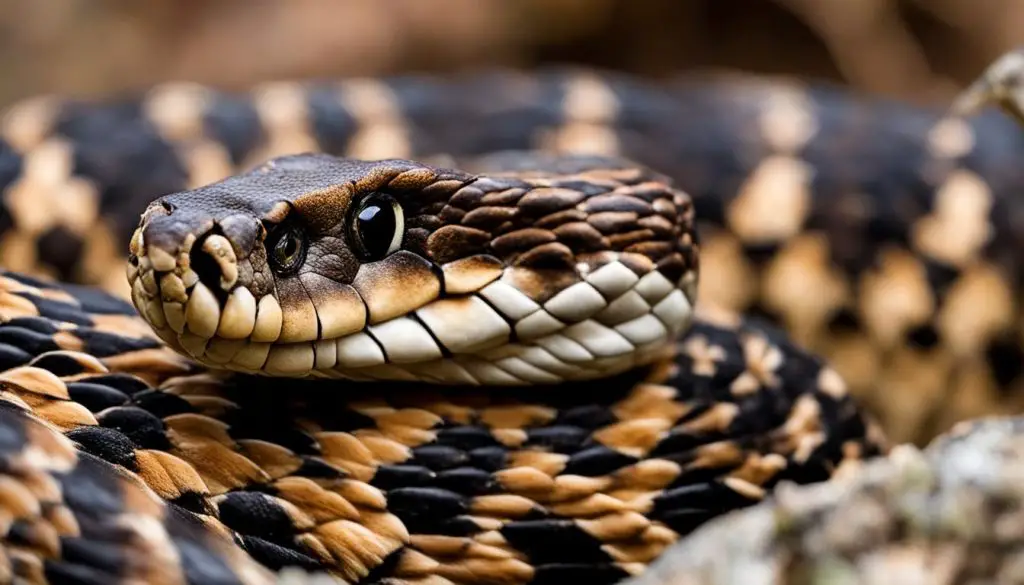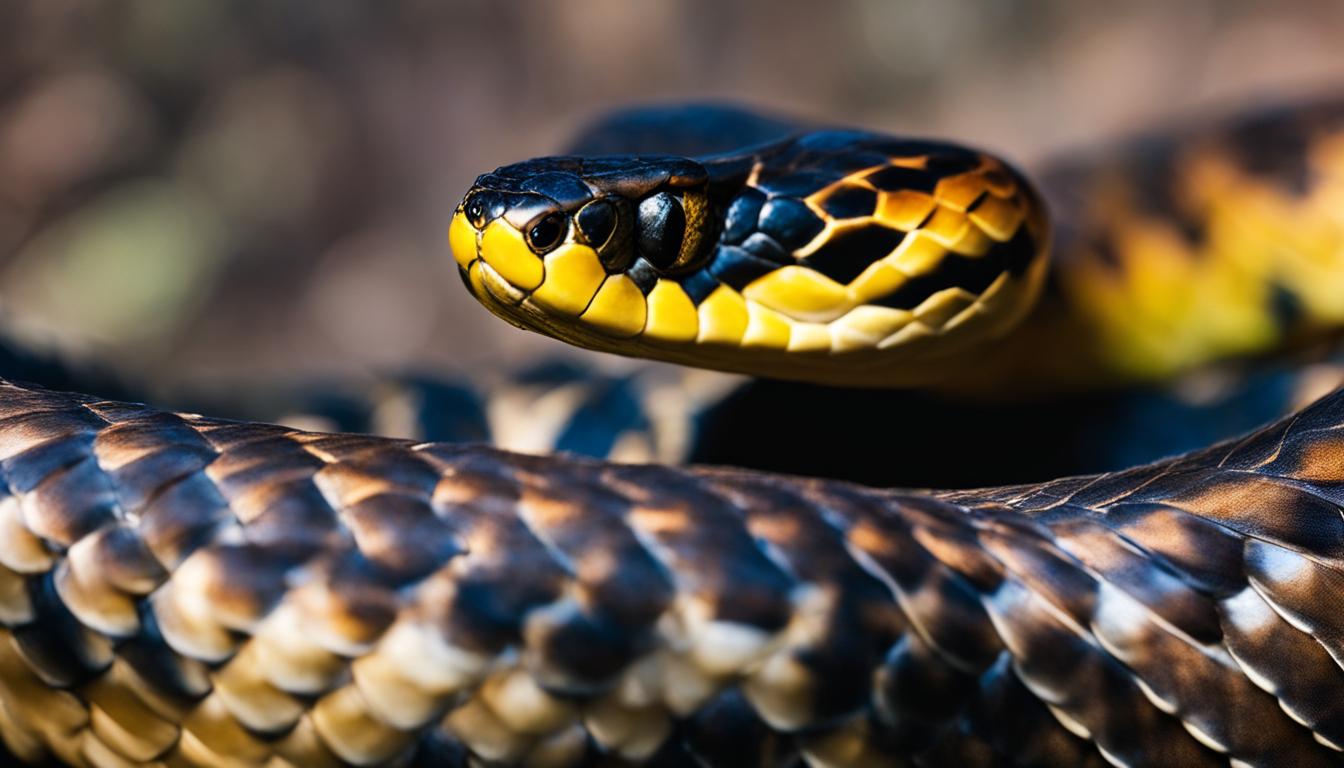Have you ever wondered if the rattles on a snake hold any significance? Are they a symbol of good luck? Let’s dive into the fascinating world of snake rattles and uncover the truth behind their mysterious charm.
Rattlesnake rattles are not simply ornaments; they serve a vital function in the snake’s survival. These rattles are made up of keratin scales that vibrate and rub against each other, producing the distinct warning sound we associate with rattlesnakes. When a rattlesnake feels threatened, it uses its instincts to know when to rattle and when not to. This rattling behavior serves as a communication tool, warning potential predators to stay away.
While snake rattles may not bring you luck in the traditional sense, they are a testament to nature’s incredible adaptations. Let’s explore the anatomy of a rattlesnake rattle, the different types of rattlesnakes, and the reasons why they may not rattle in certain situations. We will also cover how to identify rattlesnakes, their behavior, and best practices for interacting with them.
Contents
- 1 Anatomy of a Rattlesnake Rattle
- 2 Types of Rattlesnakes
- 3 Reasons why Rattlesnakes may not Rattle
- 4 Identifying Rattlesnakes
- 5 Behavior of Rattlesnakes
- 6 Interaction with Rattlesnakes
- 7 Conclusion
- 8 FAQ
- 8.1 Are snake rattles considered good luck?
- 8.2 What is the significance of snake rattles?
- 8.3 What are some types of rattlesnakes?
- 8.4 Why do rattlesnakes sometimes not rattle?
- 8.5 How can you identify a rattlesnake?
- 8.6 What is the behavior of rattlesnakes?
- 8.7 How should you interact with rattlesnakes?
- 8.8 Do snake rattles bring good luck?
- 9 Source Links
Key Takeaways:
- Snake rattles are made of keratin scales that vibrate to produce a warning sound.
- Rattlesnakes use their rattles as a communication tool to warn potential predators.
- The anatomy of a rattlesnake rattle consists of a base and segments.
- There are different species of rattlesnakes, each with its own unique characteristics and behaviors.
- Rattlesnakes may not rattle for various reasons, such as being juvenile or experiencing cool weather.
Anatomy of a Rattlesnake Rattle
Rattlesnake rattles are an extension of the snake’s tail and are made up of a base and segments. The base is attached to the tail, and the segments are hollow, air-filled scales. The number of segments can vary, with most rattlesnakes having around seven or ten. As the snake sheds its skin, new segments are added to the rattle. The rattle’s sound comes from the scales rubbing against each other as the snake moves. The rattlesnake uses its muscles to control the movement of the segments, producing different patterns of sound for communication.
Understanding the anatomy of a rattlesnake rattle is key to appreciating its significance. The rattle serves multiple purposes for the snake: it acts as a warning signal to potential threats, a communication tool for other snakes, and a mechanism for establishing dominance. The intricate structure of the rattle allows for variations in sound intensity and rhythm, conveying different messages depending on the situation.
Just as a symphony conductor uses hand movements to guide the orchestra, a rattlesnake manipulates its rattle to convey its intentions. Each movement of the rattlesnake’s tail creates a unique sound pattern, like a musical note in the snake’s repertoire.
It is fascinating to observe the complexity of the rattlesnake’s anatomy and the role it plays in the snake’s survival. The rattle serves not only as a physical attribute but also as a symbol of the snake’s power and ability to communicate with its surroundings. By understanding the anatomy of a rattlesnake rattle, we gain insight into the intricate world of these remarkable creatures.
Table: Anatomy of a Rattlesnake Rattle
| Component | Description |
|---|---|
| Base | The end of the snake’s tail where the rattle is attached. |
| Segments | Hollow, air-filled scales that make up the body of the rattle. |
| Number of Segments | Varies between rattlesnake species but typically around seven or ten. |
| Segment Growth | New segments are added as the snake sheds its skin. |
| Movement | The snake uses its muscles to control the movement of the segments, creating different patterns of sound. |
Types of Rattlesnakes
Rattlesnakes are a diverse group of venomous snakes with various species found in different regions. Each species of rattlesnake possesses unique characteristics and behaviors, contributing to their reputation as both fascinating and dangerous creatures. Here are some notable types of rattlesnakes:
1. Western Diamondback Rattlesnake
The Western Diamondback Rattlesnake is one of the most common and recognizable species. It is known for its diamond-shaped markings and distinctive rattle. Found in the southwestern United States and parts of Mexico, this rattlesnake plays a crucial role in controlling rodent populations.
2. Eastern Diamondback Rattlesnake
The Eastern Diamondback Rattlesnake is the largest venomous snake in North America. It can reach lengths of up to 8 feet and is found in the southeastern United States. Despite its size and venomous nature, this rattlesnake generally avoids confrontation and will only strike when threatened.
3. Timber Rattlesnake
The Timber Rattlesnake is a species that can be found in the eastern part of the United States. It is known for its distinctive timber-like markings, which provide excellent camouflage in forested areas. Although venomous, this rattlesnake is typically docile and prefers to avoid human interaction.
4. Mojave Rattlesnake
The Mojave Rattlesnake is known for its potent venom, which makes it one of the most dangerous rattlesnake species. Found in the southwestern United States and northern Mexico, it possesses neurotoxic venom that can cause respiratory failure in its prey. This rattlesnake is identifiable by its light-colored bands and venomous reputation.
5. Eastern Massasauga
The Eastern Massasauga is a smaller rattlesnake species found in the Great Lakes region and parts of the Midwest. It prefers wetland habitats and is known for its distinct rattling sound, often described as a “buzz.” Despite its small size, its venom can still pose a risk to human health, making caution necessary when encountering this species.
6. Pygmy Rattlesnake
The Pygmy Rattlesnake is the smallest species of rattlesnake, typically reaching lengths of only 1 to 2 feet. It is found primarily in the southeastern United States and possesses a venomous bite. Despite its small size, this rattlesnake should be treated with caution.
These are just a few examples of the variety of rattlesnake species found in different parts of the United States. Each species has its own unique characteristics and contributes to the complex ecosystem in which they reside.
| Rattlesnake Species | Region | Size | Distinctive Features |
|---|---|---|---|
| Western Diamondback Rattlesnake | Southwestern US, Mexico | Up to 7 feet | Diamond-shaped markings, potent venom |
| Eastern Diamondback Rattlesnake | Southeastern US | Up to 8 feet | Large size, distinctive diamond pattern |
| Timber Rattlesnake | Eastern US | Up to 6 feet | Timber-like markings, preference for forested areas |
| Mojave Rattlesnake | Southwestern US, Northern Mexico | Up to 4 feet | Light-colored bands, potent neurotoxic venom |
| Eastern Massasauga | Great Lakes region, Midwest | Up to 2.5 feet | Distinct “buzzing” rattle sound |
| Pygmy Rattlesnake | Southeastern US | Up to 2 feet | Small size, venomous bite |
While rattlesnakes may evoke fear and fascination, it’s crucial to respect their habitats and understand their behaviors to coexist safely. If you encounter a rattlesnake, it’s best to give it space and avoid any unnecessary interactions.

Reasons why Rattlesnakes may not Rattle
Rattlesnakes are well-known for their distinctive rattles, which serve as a warning to potential threats. However, there are instances where these snakes may not rattle, leading to misconceptions and superstitions surrounding their behavior. Here are a few reasons why rattlesnakes may choose not to use their rattle:
Few Possible Explanations:
- Juvenile Rattlesnakes: Young rattlesnakes may not have developed their rattles yet. Instead of rattling, they rely on hissing and coiling as their primary defense mechanism.
- Cool Weather: In colder temperatures, rattlesnakes can become sluggish and less active. This reduced energy may lead to a reluctance to rattle as a warning signal.
- Broken or Lost Rattles: The rattles themselves are made of fragile scales. During fights with predators or environmental interactions, these rattles can be broken or even lost, rendering the snake unable to produce the characteristic sound.
- Rare Genetic Variations: While it is not common, there have been reported cases of rattlesnakes that have lost their rattles due to genetic variations. These instances are rare, but they do occur.
It is important to understand that the absence of a rattle does not make a rattlesnake less dangerous. These snakes possess potent venoms and should always be treated with caution and respect. Additionally, if you encounter a rattlesnake, it is recommended to give it a wide berth and avoid any direct contact, irrespective of whether it rattles or not.
| Rattlesnake Rattle Behavior | |
|---|---|
| Characteristics | Reasons for Not Rattling |
| Juvenile Rattlesnakes | Underdeveloped rattles, rely on hissing and coiling |
| Cool Weather | Reduced energy and sluggishness |
| Broken or Lost Rattles | Rattlesnakes can lose or break their rattles in fights or environmental interactions |
| Rare Genetic Variations | Uncommon cases of rattlesnakes without rattles due to genetic variations |

“The absence of a rattling sound does not indicate a lesser threat from rattlesnakes. Always exercise caution in rattlesnake habitats and keep a safe distance.”
Identifying Rattlesnakes
To successfully identify a rattlesnake, there are several key characteristics to look for. These features can help you differentiate a rattlesnake from other snake species and ensure your safety when encountering one.
Rattlesnakes have a distinctive appearance with a large, triangular-shaped head. This shape is due to their venom glands, which are located on the outside of their upper jaw. Their bodies are thick and heavy, and they have vertical pupils. However, the most recognizable feature of a rattlesnake is the rattle located on the end of its tail. While the rattle may be missing in some cases, it is a crucial identifier for most rattlesnake species.

Common Characteristics to Identify Rattlesnakes:
- Large, triangular head
- Venom glands on the outside of the upper jaw
- Thick, heavy body
- Vertical pupils
- Rattle on the end of the tail (in most cases)
Properly identifying a rattlesnake is essential to ensure your safety and the snake’s well-being. If you spot a rattlesnake, it is important to give it space and avoid disturbing it. Remember, rattlesnakes are generally shy creatures and will typically only strike as a last resort when they feel threatened.
Behavior of Rattlesnakes
Rattlesnakes are fascinating creatures with unique behaviors that help them survive in their environments. Understanding their behavior is essential for coexisting safely with these creatures. Here are some key insights into the behavior of rattlesnakes:
Rattlesnakes are generally shy and non-aggressive
Rattlesnakes prefer to avoid conflict and will usually try to escape rather than engage in a confrontation. When they feel threatened, they may coil up and rattle their tails as a warning signal. This rattle serves as a way to communicate with potential predators and other snakes, indicating that they should stay away.
Heat-sensing pits and camouflage are key hunting tools
Rattlesnakes have specialized heat-sensing pits located on their faces, which allow them to detect the body heat of their prey. This unique ability helps them locate and strike at their targets with precision. Additionally, rattlesnakes have excellent camouflage, blending in with their surroundings to remain hidden from both prey and potential threats.
Striking is a last resort
Rattlesnakes will only strike as a last resort if they feel cornered or in immediate danger. They prefer to rely on their warning signals and camouflage to avoid conflict. It’s important to give rattlesnakes a wide berth and respect their space to reduce the risk of an encounter.
| Rattlesnake Behavior | Description |
|---|---|
| Rattle as a warning | Rattlesnakes use their tails to produce a distinct rattling sound, warning potential threats to stay away. |
| Heat-sensing pits | Rattlesnakes have specialized pits on their faces that help them detect the body heat of their prey. |
| Camouflage | Rattlesnakes have excellent camouflage, blending in with their surroundings to remain hidden. |
| Non-aggressive nature | Rattlesnakes are generally shy creatures that prefer to avoid confrontation and will strike as a last resort. |
Remember, if you encounter a rattlesnake in the wild, it’s important to give it space and allow it to move away. Never attempt to handle or provoke a rattlesnake, as their venomous bites can be dangerous. Respecting their behavior and their role in the ecosystem is crucial for our coexistence with these remarkable creatures.
Interaction with Rattlesnakes
When you come across a rattlesnake, it is essential to remember that these creatures are not inherently aggressive and will typically only bite when threatened. To ensure your safety and the snake’s well-being, it is crucial to give the rattlesnake space and respect its boundaries. Remember, they play a vital role in the ecosystem as natural pest control by preying on rodents.
Rattlesnakes are known for their distinct warning signal – the rattle on the end of their tail. If you hear a rattle, it is a sign that the snake feels threatened and is warning you to back away. It is crucial to recognize and respect this warning sign. Avoid making sudden movements or loud noises that might startle the snake and provoke it to strike.
If you do happen to get bitten by a rattlesnake, it is crucial to seek immediate medical attention. Rattlesnake bites are venomous and can be life-threatening if not treated promptly. Remember, snake venom can have various effects on the body, including tissue damage, blood clotting issues, and potential organ failure. The quicker you receive medical care, the better your chances of a full recovery.
| Snake Bite First Aid | Do’s | Don’ts |
|---|---|---|
| Elevate the limb | Stay calm and keep the bite area immobilized | Do not try to suck out the venom |
| Remove constrictive items (e.g., jewelry, tight clothing) | Seek medical attention immediately | Do not apply a tourniquet |
| Clean the wound with mild soap and water | Take note of the snake’s appearance to aid in identification | Do not apply ice or use a cold compress |
Remember, prevention is key when it comes to interacting with rattlesnakes. Familiarize yourself with their habitats and behaviors to minimize your chances of accidental encounters. Stay on designated trails, wear appropriate footwear, and be cautious when exploring areas known to be frequented by rattlesnakes.
Be aware, be respectful, and enjoy observing these fascinating creatures from a safe distance.
Conclusion
Rattlesnakes and their rattles are truly captivating creatures of nature. The rattles serve as essential warning signals and communication tools for these amazing animals. While there are various beliefs and superstitions surrounding the myth of snake rattles and luck, it is important to gain a deeper understanding of the biology and behavior of rattlesnakes in order to coexist safely.
Respecting the space of rattlesnakes and being cautious in their natural habitats can ensure a harmonious relationship with these remarkable creatures. It is crucial to remember that snake rattles and fortune are not synonymous, and it is a misconception to rely on the rattles as a source of luck.
By appreciating the intricate nature of rattlesnake rattles and their purpose, we can better appreciate the importance of protecting and preserving these majestic creatures for generations to come.
FAQ
Are snake rattles considered good luck?
While snake rattles are often associated with superstitions and beliefs, they are not considered to bring good luck. Instead, they serve as a warning signal for potential danger.
What is the significance of snake rattles?
Snake rattles have a biological purpose. They are made of keratin scales that vibrate and rub against each other to produce a distinct sound, serving as a warning signal to potential predators.
What are some types of rattlesnakes?
Some types of rattlesnakes include the Western diamondback rattlesnake, Eastern diamondback rattlesnake, Timber rattlesnake, Mojave rattlesnake, Eastern massasauga, and Pygmy rattlesnake.
Why do rattlesnakes sometimes not rattle?
There are several reasons why a rattlesnake may not rattle. It could be due to factors such as juvenile snakes not developing their rattles yet, cool weather making snakes sluggish, or the rattles being broken or lost through fights or environmental interactions.
How can you identify a rattlesnake?
Rattlesnakes can be identified by their large, triangular heads, venom glands on the outside of their upper jaw, thick bodies, vertical pupils, and the presence of a rattle on the end of their tail.
What is the behavior of rattlesnakes?
Rattlesnakes are generally shy creatures that prefer to avoid conflict. They will often give a warning rattle before striking to avoid confrontation. They rely on their camouflage and heat-sensing pits for hunting prey.
How should you interact with rattlesnakes?
When encountering a rattlesnake, it is important to give it space and respect its boundaries. Rattlesnakes will typically not move off the trail quickly as they are not built for speed. If bitten by a rattlesnake, seeking immediate medical attention is essential due to the venomous nature of their bites.
Do snake rattles bring good luck?
Snake rattles are not believed to bring good luck. It is important to understand the biology and behavior of rattlesnakes to coexist safely with them and avoid superstitions surrounding snake rattles and luck.





